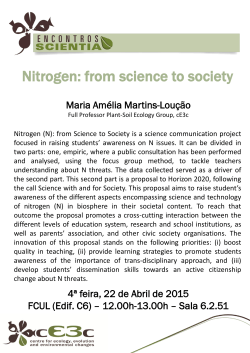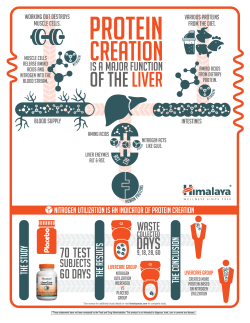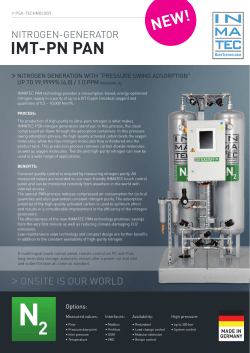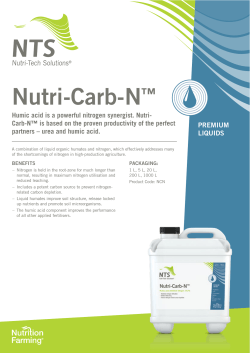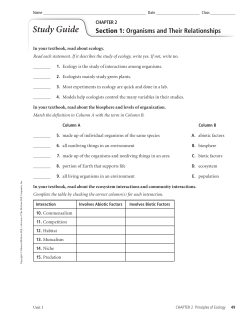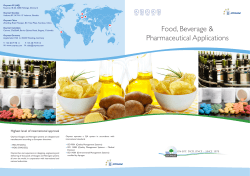
Preface - Wiley Online Library
PREFACE TO VOLUME 78 Nitrogen is everywhere! Molecular nitrogen is the largest single component of the Earth’s atmosphere (78%); it constitutes 4% of the dry weight of plant matter and 3% by weight of the human body and is absolutely essential for life. In addition, over 90% of pharmaceutical substances contain at least one nitrogen atom. Nitrogen boasts the strongest homoatomic bond rendering it chemically rather inert, but yet its fixation into plant material can be accomplished under the mildest of conditions. In his marvelous book, The Disappearing Spoon, Sean McKean eloquently summed up the idiosyncratic character of nitrogen, “That combination of plentitude, ineptitude and importance proved a natural target for ambitious chemists.” The three chapters in this volume find a common theme in that they involve the introduction (and in one case, removal) of nitrogen from organic compounds. The first chapter by Aaron Wrobleski, Thomas C. Coombs, Chan Woo Huh, Sze-Wan Li, and Jeffrey Aub´e features a classic chemical reaction for introducing nitrogen into organic compounds, namely the Schmidt Reaction. This venerable reaction usually involves the combination of hydrazoic acid with aldehydes or ketones to generate amides. In fact, the Schmidt Reaction was the subject of a previous chapter in Organic Reactions in Volume 3. Obviously, many new developments have appeared since 1946 and among the most synthetically useful are the reactions of alkyl azides with carbonyl compounds extensively developed in the Aub´e laboratories. Although the reaction of alkyl azides with ketones was known since 1955, two significant developments greatly enhanced the utility in synthesis, the advent of Lewis acid catalysis and the tethering of the azide to the carbonyl compound rendering the process intramolecular. In so doing the reaction scope expands considerably to now incorporate substrates such as enol ethers, ketals, or alcohols as the electrophilic components in addition to ketones. Aub´e and coauthors clearly outline the broad substrate scope for both inter- and intramolecular processes, clarify important constitutional and stereocontrolling features, and extensively illustrate the use of this powerful transformation in synthesis. The second chapter by William F. Berkowitz shines a spotlight on a lesswell-known, though no less fascinating transformation that introduces nitrogen into organic compounds, the Neber Rearrangement. This unique chemical reaction also begins with ketones but provides the precious nitrogen atom, not from azide, but in the form of hydroxylamine that creates an oxime derivative. Activation of the oxygen atom, usually as a sulfonate, followed by treatment with base, results in the formation of a highly strained 2H -azirine. Although azirines are themselves interesting and useful compounds, they are often hydrolyzed upon workup to form the α-amino derivative of the original ketone. A number of different mechanistic pathways have been proposed for the Neber Rearrangement and in fact, evidence has been presented that suggests more than one mechanism may be operative vii viii PREFACE TO VOLUME 78 depending upon the substrate. Whatever the mechanism, the ability to generate 2H -azirines and α-amino ketones from simple oxime sulfonates is a useful and still underappreciated reaction. Prof. Berkowitz thoroughly summarizes the state of the art, including recent advances in asymmetric variants and applications in total synthesis endeavors. The third chapter by Lynn James Guziec and Frank S. Guziec, Jr. describes an unusual class of reactions that involve the loss of small molecular fragments from a ring in service of uniting separate carbon atoms in that ring to form alkenes. These so called “extrusion reactions” are more commonly known for the loss of a single molecular fragment as in, e.g. the Ramberg-B¨acklund Reaction which has been reviewed twice in this series (L. Paquette, Volume 25 and R. J. K. Taylor and G. Casy, Volume 62). However, the chapter in this volume outranks the other extrusions in that two separate molecular fragments are lost with the formation of two new carbon-carbon bonds (twofold extrusion reactions). This remarkable transformation parlays two important features of nitrogen, first the ease of introduction into carbonyl compounds, this time with hydrazine to form hydrazones, and second the high thermochemical stability of molecular nitrogen which is lost as one of the fragments. Although a number of different double extrusion reactions are described, many involve the formation of a 1,3,4-thiadiazoline ring from a diazoalkane (derived from the hydrazone) and a thioketone. The magic happens upon thermolysis of the 1,3,4-thiadiazoline in the presence of a thiophile. The highly exergonic nature of the reaction allows for the formation of highly strained and hindered alkenes. It is appropriate here to acknowledge the expert assistance of the entire editorial board, but in this case, special thanks to Stuart W. McCombie who shepherded all three chapters in this volume. The contributions of the authors, editors, and the publisher were expertly coordinated by the responsible secretary, Jeffery B. Press. In addition, the Organic Reactions enterprise could not maintain the quality of production without the dedicated efforts of its editorial staff, Dr. Linda S. Press and Dr. Danielle Soenen. Insofar as the essence of Organic Reactions chapters resides in the massive tables of examples, the painstaking efforts of authors and editorial coordinators are highly prized. SCOTT E. DENMARK Urbana, Illinois
© Copyright 2025
